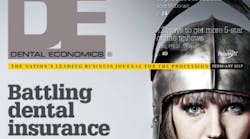A force to be reckoned with
Dr. Scott Cairns analzyes why pathologies of occlusion are infrequently observed, discussed, and treated by today's dentists, and how this can be changed.
Dental schools across the country do an excellent job of teaching us to diagnose pathology resulting from microorganisms. Rarely do we miss decay, gingivitis, periodontitis, periapical periodontitis, or abscesses. However, other pathologies of the oral cavity, including microtrauma resulting from forces, are much less observed, discussed, and treated. Why?
We don't seem to be as concerned with diagnosing diseases of force. Microtrauma is not difficult or expensive to diagnose (the simplest test is to use your fingernail to evaluate fremitus), and the signs are easy to visualize and catalog. Still, diagnoses are uncommon. After giving this situation considerable thought, I believe there are eight likely reasons why we are not treating diseases of force consistently. Once we recognize these barriers, we can find ways to overcome them.
All eight factors feed upon one another, creating a feedback loop that can further suppress care:
- Uncertainty regarding the cause
- Patients' absence of concern
- Dentists' avoidance
- Lack of advanced training
- Treatment uncertainty
- Lack of third-party payer support
- Interrelatedness to medical conditions
- Little public awareness
Let's consider these reasons in depth.
Uncertainty regarding the cause
Dentistry recognizes that two colliding objects create a transference force, and that this energy transfer occurs when we eat and swallow. What is less known is why some people exert more energy than others when squeezing and bruxing their teeth. Theories abound, but there is no question that some people have more damage to the stomatological system than others. Still, confusion, disagreement, uncertainty, and conflict among dental professionals exists. Is confusion what has stalled us from improving the health and well-being of the public?
The dogmatism and ideology that exists in our profession is not helpful in preventing or treating disease. Even if we can't agree on the best way to create occlusion, we can agree that we should try to protect teeth and disperse forces. As dentists, we can give people back a semblance of natural dental morphology in a way that promotes longevity of the system.
Patients' absence of concern
Every dentist who has ever tried to explain attrition knows that most patients show little concern. This becomes a barrier in trying to help people move forward with treatment. It is difficult to help people do something today to prevent something in the future. As dentists, our challenge is to help bring the future reward to the present for our patients.
Dentists' avoidance
Most dentists see the signs but choose to avoid a challenging conversation with a patient about a disease process that is not fully understood. Once treatment becomes paramount, it can seem like a daunting challenge to repair. We question how to have a conversation with a patient about a process that has progressed under our watch. The cascade of negative events is unpleasant, but it is well into the future and thus easy to ignore today.
Lack of advanced training
Many dentists don't have a deep enough knowledge of all factors associated with the pathology to know how to provide care, and dentistry does not have a consensus on how best to treat this problem. Dentists can seek out advanced training in occlusion, TMD, sleep apnea, orofacial pain, and orthodontics. This training is readily available from the major teaching institutes, such as the Kois Center, Spear Education, the Pankey Institute, and the Dawson Academy.
Treatment uncertainty
It's easy for dentistry's lack of consensus on treatment to freeze some dentists with uncertainty. Frank Spear, DDS, suggests that most of the theories work. We can't let the dogmatic infighting of different camps preclude us from learning occlusion. Start with one of the camps to begin learning. It takes time, and more importantly practice, to learn occlusion.
Lack of third-party payer support
Dental insurance is a blessing and a curse. Dental insurance brings many patients to our offices who would not otherwise be willing or able, but it is also a business that makes money when patients choose not to get treatment or choose less comprehensive treatments. Because patients feel they have already made the investment in dental insurance, they want to use their benefits and trust the insurance companies to cover necessary procedures. When insurance does not cover something, many patients will draw the conclusion that they must not need it. Any attempt to point out the financial incentive the carrier has to delay or avoid treatment is generally not received well by the patient and can have a dampening effect on care.
Interrelatedness to medical conditions
Perhaps one of the most astounding aspects of the human body is how much of its function occurs without any cognitive thought. The body is compensating for thousands of factors outside of human consciousness at all times. Our teeth are just one cog in the wheel of existence-they are an important part of the body, but not the most important part. Breathing is perhaps the most essential of all life functions: we can go days without food, hours without water, but only minutes without air. If our body begins to experience hypoxia, it will automatically do many things to ensure a patent airway. The airway will likely prove to be one of the most significant factors in occlusal disease.
Little public awareness
The public's lack of awareness about the destructive nature of force in the mouth correlates highly to a lack of patient concern. Companies such as Crest and Oral-B have done an outstanding job of educating the public about the bacterial components of oral pathology. Unfortunately, force does not have any champion to raise awareness. It only has dentistry, which is besieged by the issues I've discussed.
As dentists, our job is to treat and prevent oral disease. Ultimately, patients get to choose treatment and deserve to know every identifiable diagnosis. You can reflect on these eight factors and decide which are within your own control. By recognizing which of these barriers may be present in your practice, you can begin to address them and better serve your patients in the prevention and treatment of all diseases of the oral cavity. It's never too late to add a skill set—make 2017 the year where occlusion becomes part of your continuing education plan.
Scott Cairns, DDS, graduated from Creighton University School of Dentistry in 1999. He is a multioffice owner-dentist supported by Pacific Dental Services (PDS), a faculty member of the PDS Institute, a member of the L. D. Pankey Alumni Association, and a former Spear Faculty Club member.
RELATED:

